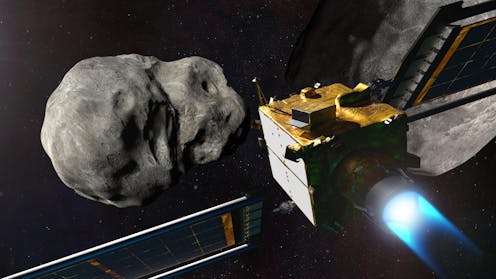NASA’s DART (Double Asteroid Redirection Test) mission was hailed a success when it collided with its target asteroid Dimorphos last year. The purpose of the endeavour was to see if it could redirect an asteroid and, since the impact, astronomers have been measuring and calculating the impact on the target. It is incredible that the 580kg spacecraft travelling at 6 km/s was able to impart enormous kinetic energy to the 5 billion kg asteroid.
The DART mission, launched by NASA in 2021, aimed to test our ability to deflect asteroids. By crashing a spacecraft into the smaller asteroid of the Didymos binary system, DART was to demonstrate the effectiveness of kinetic impactors in altering an asteroid’s trajectory. This mission marked a crucial step in planetary defence, showcasing technology that could one day protect us from potential asteroid impacts.
Studies from the impact have shown that the kinetic impact approach for deflecting asteroids is a viable approach. Earth-based observations indicate that Dimorphos’ orbit around its parent asteroid, Didymos, decreased by approximately 33 minutes. However, researchers remain uncertain about the overall ‘impact’ to the asteroid from the spacecraft’s impact. Additionally to be able to understand the efficiency of the moment transfer from the impact (known as the beta factor) a precise measurement fo the asteroids mass must be known. This is up to the Hera mission to achieve.

Hera is a European Space Agency mission due for launch in October 2024 and arrive in 2026. Its purpose is to survey the Didymos binary asteroid system following the DART impact. Hera will measure the mass accurately but will also attempt to measure the recoil from material ejected out into space. We already have some information from the Italian LICIACube, images from James Webb and Hubble show a plume of debris that extended 10,000 km into space.
While we wait for Hera to arrive, research teams have been simulating the DART impact using the Bern Smoothed Particle Hydrodynamics impact code (SPH). It was developed at the University of Bern and was designed to model the break up of rocky bodies from collisions. It’s a fascinating tool that converts colliding bodies into millions of individual particles whose behaviours are informed by the laws of physics. This isn’t just some whimsical game though, the software has been used already to reproduce the impact of Japan’s Hayabusa2 spacecraft with the asteroid Ryugu.
The simulation is very timely taking about a week and a half to run a simulation. In total, despite the slow processing, around 250 simulations were run. Asteroid parameters that were known were used in the simulation with others being varied where the information was not well known. The team then looked at which outcome most closely matched observation.
Running these simulations for Dimorphos revealed an asteroid that is largely a weak pile of rubble held together by a weak gravitational field rather than general cohesive strength. To understand cohesion, imagine the difference between a ‘poured’ pile of sand or flour. The flour would form a taller cone shape (high cohesivity) whereas the sand would be a flatter pile (low cohesivity). It is believed that the impact site would have formed a crater but the crater would likely have grown to encompass a good proportion of the asteroid, and the low gravity and cohesivity is likely to have reshaped the asteroid.
The data suggests that 1% of the entire mass of Dimorphos was ejected into space by the impact and that 8% of the mass was likely to have been shifted around its body. All of this is from simulations but we won’t know for sure just what impact DART had on Dimorphus, not until Hera arrives in two years time.
Source : DART impact might have reshaped Hera’s target asteroid


was Didymos trajectory also changed after this experiment? By how much?